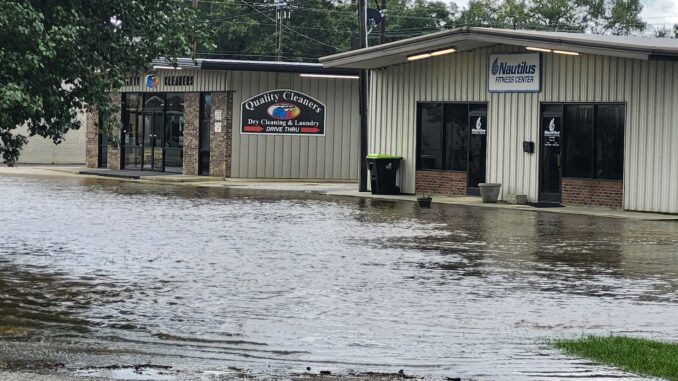
As the first tropical system of the season gets underway, officials and owners of flood-prone property in Whiteville are getting ready.
Last week’s heavy rains on Wednesday were a wakeup call, City Manager Darren Currie said.
“We had places that saw water that haven’t flooded in a long time,” he said. “We’re trying to find out why.”
Meteorologist Christopher Cawley’s weather gauge on College Street registered 2.75 inches officially, but other backyard gauges ranged from two to as much as six inches in Nakina.
A team of volunteers and an explosives expert blew the large beaver dam in Soules Swamp several days before the storm, likely contributing to the lack of flooding downtown. Other areas, however, surprised motorists who are used to high water during big storms.
“We’re still trying to figure some of that out,” Currie said.
The intersection of Washington and Powell in Whiteville is no stranger to high water, but the most recent downpour sent water flowing to several businesses as well as spreading out farther than usual. Some said the flooding in that area was as bad as Hurricane Florence in 2018, despite major improvements to stormwater drainage by the Dept. of Transportation during the U.S. 701 Bypass project.
Farther out on U.S. 701 North, rainwater floated a dumpster at the Food Lion North shopping center, and water approached Southern Veterinary Hospital on Washington Street.
Currie noted that, as required by ordinance, there are retention ponds along the path of the stormwater’s path to White Marsh and Soules Swamp. The ponds allow runoff to gradually work its way down, instead of causing a rapid and destructive rise in water levels.
“Those ponds can hold just so much,” he said. “Like I always say – If you pour a five gallon bucket of water into the a sink real slowly, it doesn’t spill and it can handle it. If you dump the bucket in there, some of it going to spill.”
Flooding was worse than usual along College Street as well, and even some northern sections of Madison saw high water despite being close to the higher elevation end of the street.
Mollies Branch rose faster than usual, Currie said, then dropped fairly quickly as well.
City crews taped off Walter and sections of Main Street downtown to prevent damage caused by wakes created by people driving through floodwater, but some drivers ignored or drove around barricades and caution tape.
Walter Street saw significant flooding, but Collision Center employees at Lee and Walter streets took matters into their own hands and blocked the street with a flatbed wrecker.
Currie said he felt some of the flooding was avoided because citizens “have been taking the initiative”, not just with blowing the dam in Soules Swamp but in other ways.
“Anything that government does requires red tape,” he said. “We have to have permits, sufficient funding, permission if the problem is on private property, all kinds of hoops to jump through. Some of these things can be handled much easier by regular people. The city doesn’t maintain privately owned ditches, and they are a major part of our drainage system.”
The recent loss of more than $5 million in federal flood mitigation funding was a blow, Currie said, but the city is hunting for other sources for the money. He said he is cautiously optimistic that new funding will be found to help with Mollie’s Branch, which in turn will help control floodwater heading downstream to the marsh.
City officials are also in the final stages of an agreement with R.J. Corman Railroad that will allow larger culverts to be installed under the railbed along Canal Street, thus stopping the railroad from acting like a dam.
A total revamp of Franklin Street set for the spring will also include drainage improvements. The city is also working with private landowners to get easements to install drainlines in some perennial trouble spots.
In the end, Currie said, the city is still going to be flat, with some downtown areas built on filled-in portions of Soules Swamp.
“Elevation is our nemesis, and always will be,” he said. “You can only get so much water to flow off so fast, especially with all the impermeable surfaces we have. When there’s a big rain, we are going to have some flooding.” We can’t around that, but we can keep trying to control it.”























